Strategic Management Accounting: ABC Implementation Issues Analysis
VerifiedAdded on 2022/11/28
|14
|3733
|1
Report
AI Summary
This report examines the issues surrounding the implementation of Activity Based Costing (ABC) within organizations. The paper reviews literature to identify key challenges associated with ABC, including limitations in overhead cost allocation, particularly for companies with small data or volume. The report explores issues in supply chain management, performance evaluation, and quality management, highlighting how the method may not effectively capture the costs of all activities. It also discusses the impact of ABC on stakeholders, emphasizing the importance of accurate performance evaluation and the need for effective cost management strategies to meet stakeholder expectations. The study presents different viewpoints on the effectiveness of ABC, emphasizing the importance of information sharing, communication, and trust in enhancing performance and integrated supply chain management.

Management accounting
5 / 1 8 / 2 0 1 9
5 / 1 8 / 2 0 1 9
Paraphrase This Document
Need a fresh take? Get an instant paraphrase of this document with our AI Paraphraser
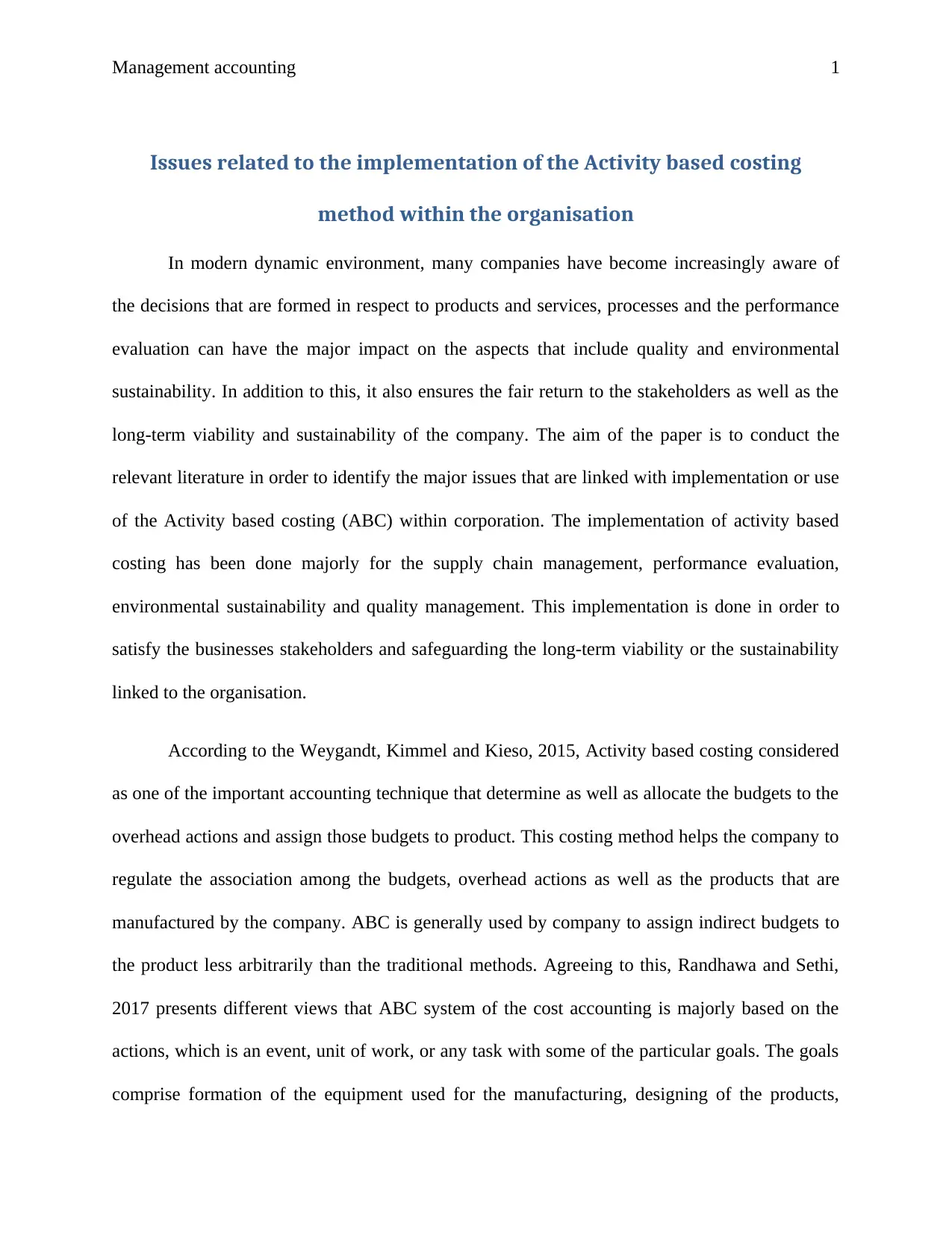
Management accounting 1
Issues related to the implementation of the Activity based costing
method within the organisation
In modern dynamic environment, many companies have become increasingly aware of
the decisions that are formed in respect to products and services, processes and the performance
evaluation can have the major impact on the aspects that include quality and environmental
sustainability. In addition to this, it also ensures the fair return to the stakeholders as well as the
long-term viability and sustainability of the company. The aim of the paper is to conduct the
relevant literature in order to identify the major issues that are linked with implementation or use
of the Activity based costing (ABC) within corporation. The implementation of activity based
costing has been done majorly for the supply chain management, performance evaluation,
environmental sustainability and quality management. This implementation is done in order to
satisfy the businesses stakeholders and safeguarding the long-term viability or the sustainability
linked to the organisation.
According to the Weygandt, Kimmel and Kieso, 2015, Activity based costing considered
as one of the important accounting technique that determine as well as allocate the budgets to the
overhead actions and assign those budgets to product. This costing method helps the company to
regulate the association among the budgets, overhead actions as well as the products that are
manufactured by the company. ABC is generally used by company to assign indirect budgets to
the product less arbitrarily than the traditional methods. Agreeing to this, Randhawa and Sethi,
2017 presents different views that ABC system of the cost accounting is majorly based on the
actions, which is an event, unit of work, or any task with some of the particular goals. The goals
comprise formation of the equipment used for the manufacturing, designing of the products,
Issues related to the implementation of the Activity based costing
method within the organisation
In modern dynamic environment, many companies have become increasingly aware of
the decisions that are formed in respect to products and services, processes and the performance
evaluation can have the major impact on the aspects that include quality and environmental
sustainability. In addition to this, it also ensures the fair return to the stakeholders as well as the
long-term viability and sustainability of the company. The aim of the paper is to conduct the
relevant literature in order to identify the major issues that are linked with implementation or use
of the Activity based costing (ABC) within corporation. The implementation of activity based
costing has been done majorly for the supply chain management, performance evaluation,
environmental sustainability and quality management. This implementation is done in order to
satisfy the businesses stakeholders and safeguarding the long-term viability or the sustainability
linked to the organisation.
According to the Weygandt, Kimmel and Kieso, 2015, Activity based costing considered
as one of the important accounting technique that determine as well as allocate the budgets to the
overhead actions and assign those budgets to product. This costing method helps the company to
regulate the association among the budgets, overhead actions as well as the products that are
manufactured by the company. ABC is generally used by company to assign indirect budgets to
the product less arbitrarily than the traditional methods. Agreeing to this, Randhawa and Sethi,
2017 presents different views that ABC system of the cost accounting is majorly based on the
actions, which is an event, unit of work, or any task with some of the particular goals. The goals
comprise formation of the equipment used for the manufacturing, designing of the products,
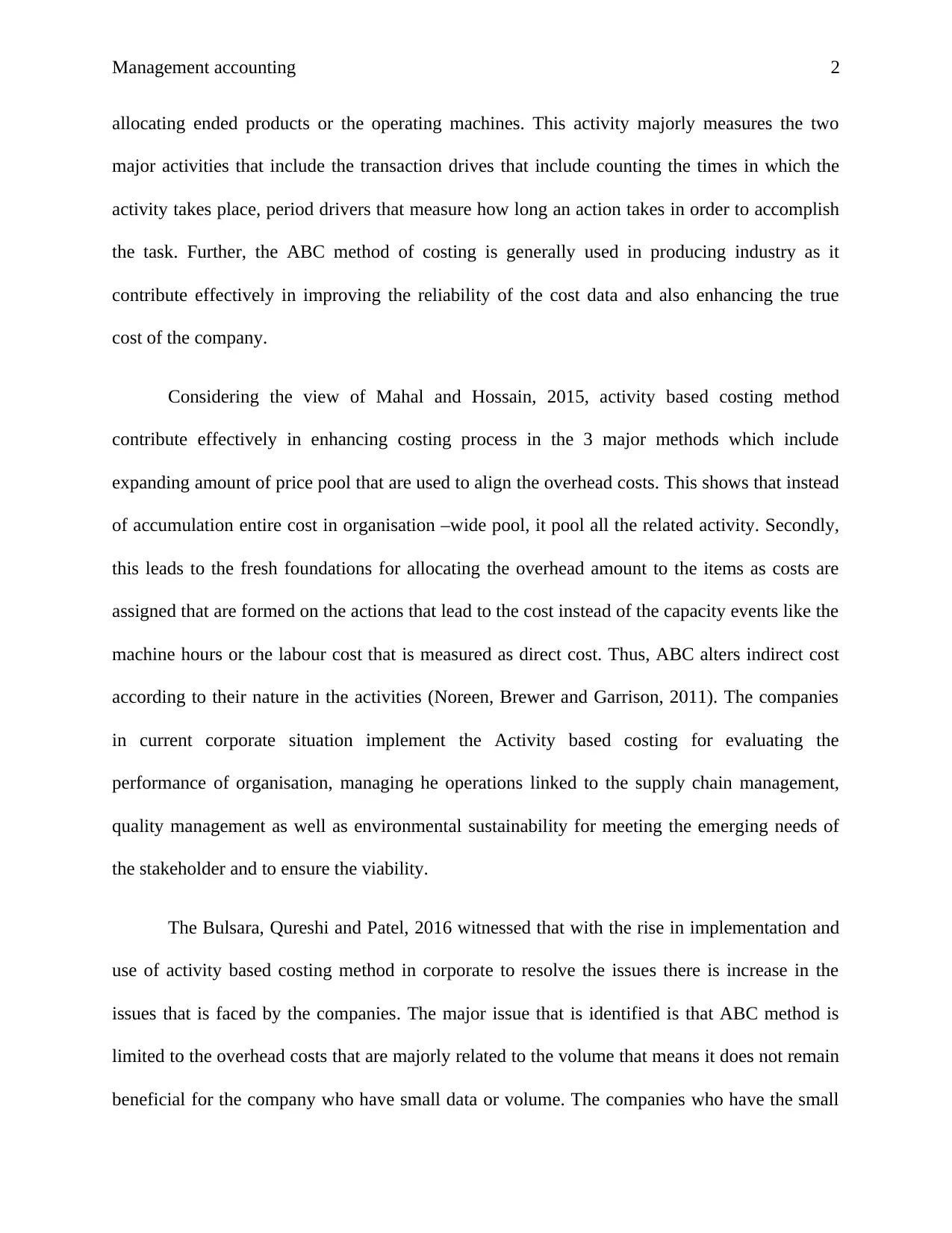
Management accounting 2
allocating ended products or the operating machines. This activity majorly measures the two
major activities that include the transaction drives that include counting the times in which the
activity takes place, period drivers that measure how long an action takes in order to accomplish
the task. Further, the ABC method of costing is generally used in producing industry as it
contribute effectively in improving the reliability of the cost data and also enhancing the true
cost of the company.
Considering the view of Mahal and Hossain, 2015, activity based costing method
contribute effectively in enhancing costing process in the 3 major methods which include
expanding amount of price pool that are used to align the overhead costs. This shows that instead
of accumulation entire cost in organisation –wide pool, it pool all the related activity. Secondly,
this leads to the fresh foundations for allocating the overhead amount to the items as costs are
assigned that are formed on the actions that lead to the cost instead of the capacity events like the
machine hours or the labour cost that is measured as direct cost. Thus, ABC alters indirect cost
according to their nature in the activities (Noreen, Brewer and Garrison, 2011). The companies
in current corporate situation implement the Activity based costing for evaluating the
performance of organisation, managing he operations linked to the supply chain management,
quality management as well as environmental sustainability for meeting the emerging needs of
the stakeholder and to ensure the viability.
The Bulsara, Qureshi and Patel, 2016 witnessed that with the rise in implementation and
use of activity based costing method in corporate to resolve the issues there is increase in the
issues that is faced by the companies. The major issue that is identified is that ABC method is
limited to the overhead costs that are majorly related to the volume that means it does not remain
beneficial for the company who have small data or volume. The companies who have the small
allocating ended products or the operating machines. This activity majorly measures the two
major activities that include the transaction drives that include counting the times in which the
activity takes place, period drivers that measure how long an action takes in order to accomplish
the task. Further, the ABC method of costing is generally used in producing industry as it
contribute effectively in improving the reliability of the cost data and also enhancing the true
cost of the company.
Considering the view of Mahal and Hossain, 2015, activity based costing method
contribute effectively in enhancing costing process in the 3 major methods which include
expanding amount of price pool that are used to align the overhead costs. This shows that instead
of accumulation entire cost in organisation –wide pool, it pool all the related activity. Secondly,
this leads to the fresh foundations for allocating the overhead amount to the items as costs are
assigned that are formed on the actions that lead to the cost instead of the capacity events like the
machine hours or the labour cost that is measured as direct cost. Thus, ABC alters indirect cost
according to their nature in the activities (Noreen, Brewer and Garrison, 2011). The companies
in current corporate situation implement the Activity based costing for evaluating the
performance of organisation, managing he operations linked to the supply chain management,
quality management as well as environmental sustainability for meeting the emerging needs of
the stakeholder and to ensure the viability.
The Bulsara, Qureshi and Patel, 2016 witnessed that with the rise in implementation and
use of activity based costing method in corporate to resolve the issues there is increase in the
issues that is faced by the companies. The major issue that is identified is that ABC method is
limited to the overhead costs that are majorly related to the volume that means it does not remain
beneficial for the company who have small data or volume. The companies who have the small
⊘ This is a preview!⊘
Do you want full access?
Subscribe today to unlock all pages.

Trusted by 1+ million students worldwide
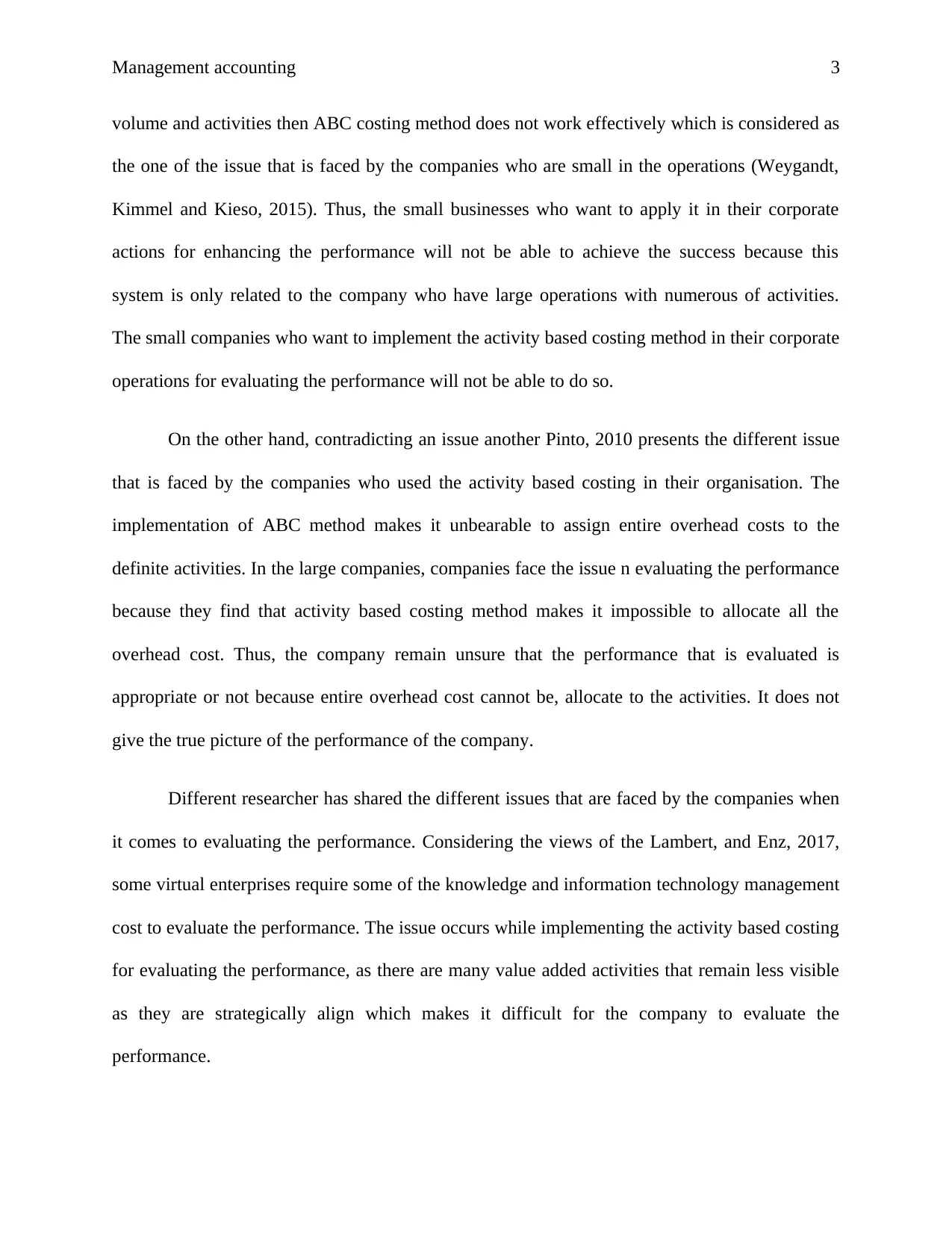
Management accounting 3
volume and activities then ABC costing method does not work effectively which is considered as
the one of the issue that is faced by the companies who are small in the operations (Weygandt,
Kimmel and Kieso, 2015). Thus, the small businesses who want to apply it in their corporate
actions for enhancing the performance will not be able to achieve the success because this
system is only related to the company who have large operations with numerous of activities.
The small companies who want to implement the activity based costing method in their corporate
operations for evaluating the performance will not be able to do so.
On the other hand, contradicting an issue another Pinto, 2010 presents the different issue
that is faced by the companies who used the activity based costing in their organisation. The
implementation of ABC method makes it unbearable to assign entire overhead costs to the
definite activities. In the large companies, companies face the issue n evaluating the performance
because they find that activity based costing method makes it impossible to allocate all the
overhead cost. Thus, the company remain unsure that the performance that is evaluated is
appropriate or not because entire overhead cost cannot be, allocate to the activities. It does not
give the true picture of the performance of the company.
Different researcher has shared the different issues that are faced by the companies when
it comes to evaluating the performance. Considering the views of the Lambert, and Enz, 2017,
some virtual enterprises require some of the knowledge and information technology management
cost to evaluate the performance. The issue occurs while implementing the activity based costing
for evaluating the performance, as there are many value added activities that remain less visible
as they are strategically align which makes it difficult for the company to evaluate the
performance.
volume and activities then ABC costing method does not work effectively which is considered as
the one of the issue that is faced by the companies who are small in the operations (Weygandt,
Kimmel and Kieso, 2015). Thus, the small businesses who want to apply it in their corporate
actions for enhancing the performance will not be able to achieve the success because this
system is only related to the company who have large operations with numerous of activities.
The small companies who want to implement the activity based costing method in their corporate
operations for evaluating the performance will not be able to do so.
On the other hand, contradicting an issue another Pinto, 2010 presents the different issue
that is faced by the companies who used the activity based costing in their organisation. The
implementation of ABC method makes it unbearable to assign entire overhead costs to the
definite activities. In the large companies, companies face the issue n evaluating the performance
because they find that activity based costing method makes it impossible to allocate all the
overhead cost. Thus, the company remain unsure that the performance that is evaluated is
appropriate or not because entire overhead cost cannot be, allocate to the activities. It does not
give the true picture of the performance of the company.
Different researcher has shared the different issues that are faced by the companies when
it comes to evaluating the performance. Considering the views of the Lambert, and Enz, 2017,
some virtual enterprises require some of the knowledge and information technology management
cost to evaluate the performance. The issue occurs while implementing the activity based costing
for evaluating the performance, as there are many value added activities that remain less visible
as they are strategically align which makes it difficult for the company to evaluate the
performance.
Paraphrase This Document
Need a fresh take? Get an instant paraphrase of this document with our AI Paraphraser
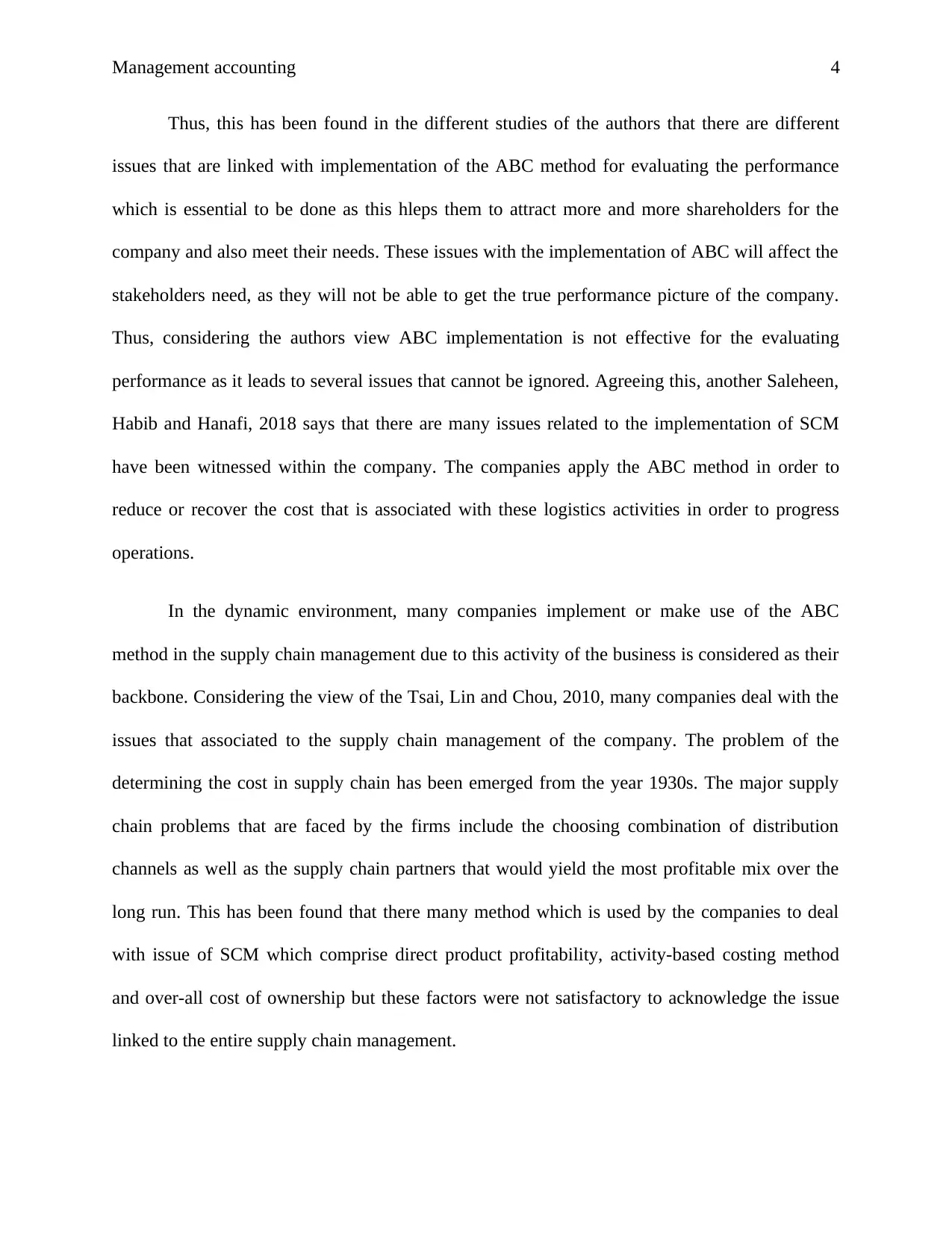
Management accounting 4
Thus, this has been found in the different studies of the authors that there are different
issues that are linked with implementation of the ABC method for evaluating the performance
which is essential to be done as this hleps them to attract more and more shareholders for the
company and also meet their needs. These issues with the implementation of ABC will affect the
stakeholders need, as they will not be able to get the true performance picture of the company.
Thus, considering the authors view ABC implementation is not effective for the evaluating
performance as it leads to several issues that cannot be ignored. Agreeing this, another Saleheen,
Habib and Hanafi, 2018 says that there are many issues related to the implementation of SCM
have been witnessed within the company. The companies apply the ABC method in order to
reduce or recover the cost that is associated with these logistics activities in order to progress
operations.
In the dynamic environment, many companies implement or make use of the ABC
method in the supply chain management due to this activity of the business is considered as their
backbone. Considering the view of the Tsai, Lin and Chou, 2010, many companies deal with the
issues that associated to the supply chain management of the company. The problem of the
determining the cost in supply chain has been emerged from the year 1930s. The major supply
chain problems that are faced by the firms include the choosing combination of distribution
channels as well as the supply chain partners that would yield the most profitable mix over the
long run. This has been found that there many method which is used by the companies to deal
with issue of SCM which comprise direct product profitability, activity-based costing method
and over-all cost of ownership but these factors were not satisfactory to acknowledge the issue
linked to the entire supply chain management.
Thus, this has been found in the different studies of the authors that there are different
issues that are linked with implementation of the ABC method for evaluating the performance
which is essential to be done as this hleps them to attract more and more shareholders for the
company and also meet their needs. These issues with the implementation of ABC will affect the
stakeholders need, as they will not be able to get the true performance picture of the company.
Thus, considering the authors view ABC implementation is not effective for the evaluating
performance as it leads to several issues that cannot be ignored. Agreeing this, another Saleheen,
Habib and Hanafi, 2018 says that there are many issues related to the implementation of SCM
have been witnessed within the company. The companies apply the ABC method in order to
reduce or recover the cost that is associated with these logistics activities in order to progress
operations.
In the dynamic environment, many companies implement or make use of the ABC
method in the supply chain management due to this activity of the business is considered as their
backbone. Considering the view of the Tsai, Lin and Chou, 2010, many companies deal with the
issues that associated to the supply chain management of the company. The problem of the
determining the cost in supply chain has been emerged from the year 1930s. The major supply
chain problems that are faced by the firms include the choosing combination of distribution
channels as well as the supply chain partners that would yield the most profitable mix over the
long run. This has been found that there many method which is used by the companies to deal
with issue of SCM which comprise direct product profitability, activity-based costing method
and over-all cost of ownership but these factors were not satisfactory to acknowledge the issue
linked to the entire supply chain management.
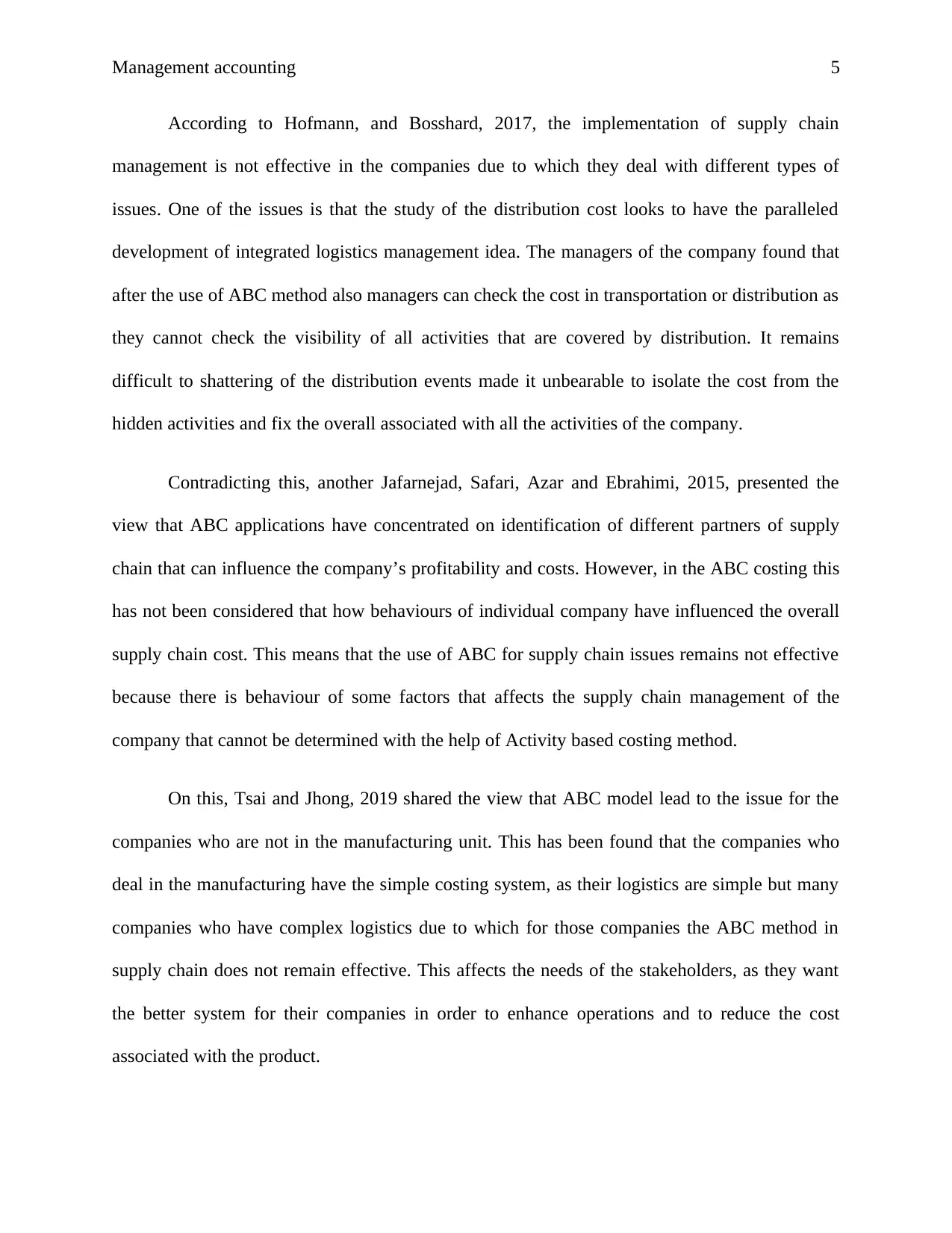
Management accounting 5
According to Hofmann, and Bosshard, 2017, the implementation of supply chain
management is not effective in the companies due to which they deal with different types of
issues. One of the issues is that the study of the distribution cost looks to have the paralleled
development of integrated logistics management idea. The managers of the company found that
after the use of ABC method also managers can check the cost in transportation or distribution as
they cannot check the visibility of all activities that are covered by distribution. It remains
difficult to shattering of the distribution events made it unbearable to isolate the cost from the
hidden activities and fix the overall associated with all the activities of the company.
Contradicting this, another Jafarnejad, Safari, Azar and Ebrahimi, 2015, presented the
view that ABC applications have concentrated on identification of different partners of supply
chain that can influence the company’s profitability and costs. However, in the ABC costing this
has not been considered that how behaviours of individual company have influenced the overall
supply chain cost. This means that the use of ABC for supply chain issues remains not effective
because there is behaviour of some factors that affects the supply chain management of the
company that cannot be determined with the help of Activity based costing method.
On this, Tsai and Jhong, 2019 shared the view that ABC model lead to the issue for the
companies who are not in the manufacturing unit. This has been found that the companies who
deal in the manufacturing have the simple costing system, as their logistics are simple but many
companies who have complex logistics due to which for those companies the ABC method in
supply chain does not remain effective. This affects the needs of the stakeholders, as they want
the better system for their companies in order to enhance operations and to reduce the cost
associated with the product.
According to Hofmann, and Bosshard, 2017, the implementation of supply chain
management is not effective in the companies due to which they deal with different types of
issues. One of the issues is that the study of the distribution cost looks to have the paralleled
development of integrated logistics management idea. The managers of the company found that
after the use of ABC method also managers can check the cost in transportation or distribution as
they cannot check the visibility of all activities that are covered by distribution. It remains
difficult to shattering of the distribution events made it unbearable to isolate the cost from the
hidden activities and fix the overall associated with all the activities of the company.
Contradicting this, another Jafarnejad, Safari, Azar and Ebrahimi, 2015, presented the
view that ABC applications have concentrated on identification of different partners of supply
chain that can influence the company’s profitability and costs. However, in the ABC costing this
has not been considered that how behaviours of individual company have influenced the overall
supply chain cost. This means that the use of ABC for supply chain issues remains not effective
because there is behaviour of some factors that affects the supply chain management of the
company that cannot be determined with the help of Activity based costing method.
On this, Tsai and Jhong, 2019 shared the view that ABC model lead to the issue for the
companies who are not in the manufacturing unit. This has been found that the companies who
deal in the manufacturing have the simple costing system, as their logistics are simple but many
companies who have complex logistics due to which for those companies the ABC method in
supply chain does not remain effective. This affects the needs of the stakeholders, as they want
the better system for their companies in order to enhance operations and to reduce the cost
associated with the product.
⊘ This is a preview!⊘
Do you want full access?
Subscribe today to unlock all pages.

Trusted by 1+ million students worldwide
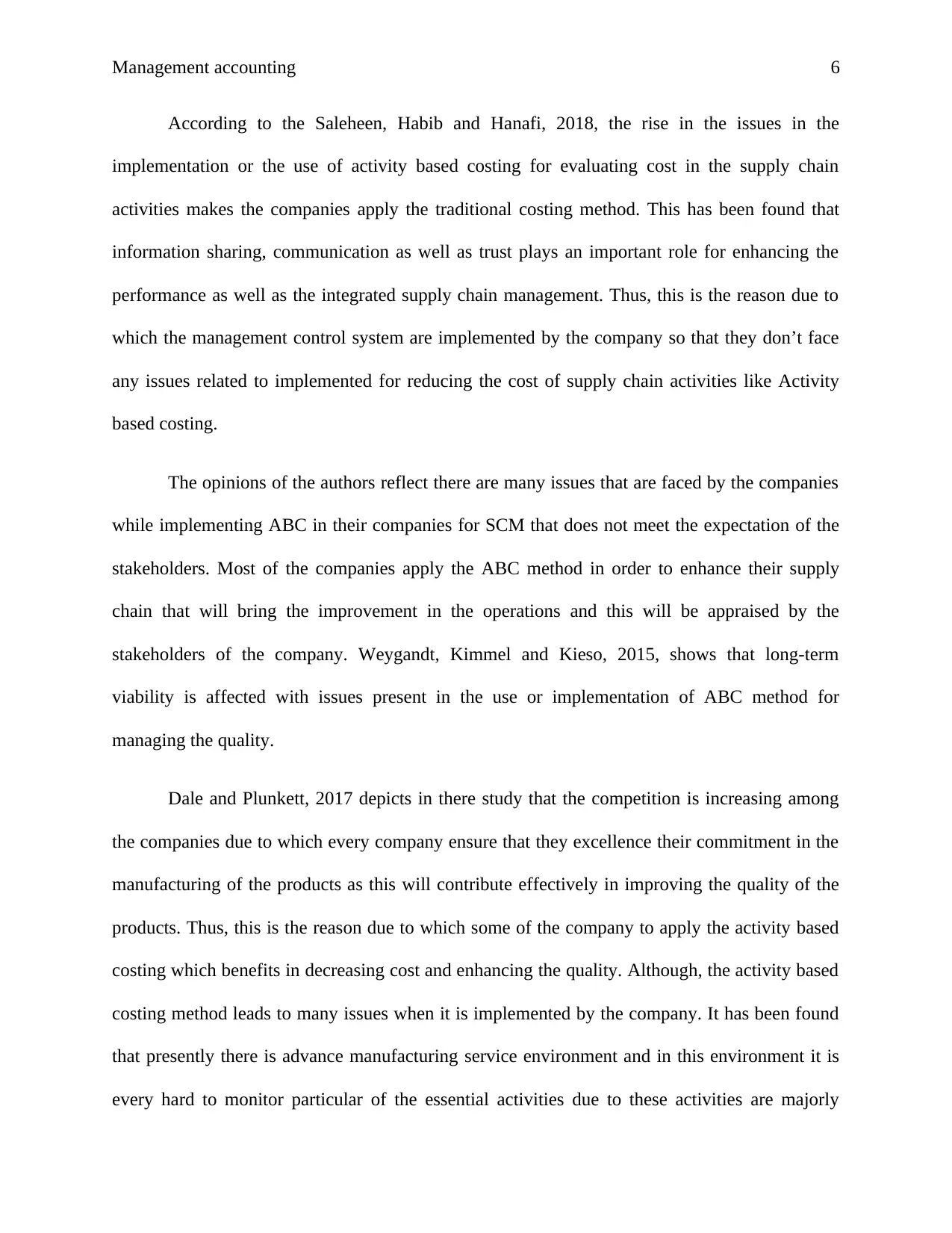
Management accounting 6
According to the Saleheen, Habib and Hanafi, 2018, the rise in the issues in the
implementation or the use of activity based costing for evaluating cost in the supply chain
activities makes the companies apply the traditional costing method. This has been found that
information sharing, communication as well as trust plays an important role for enhancing the
performance as well as the integrated supply chain management. Thus, this is the reason due to
which the management control system are implemented by the company so that they don’t face
any issues related to implemented for reducing the cost of supply chain activities like Activity
based costing.
The opinions of the authors reflect there are many issues that are faced by the companies
while implementing ABC in their companies for SCM that does not meet the expectation of the
stakeholders. Most of the companies apply the ABC method in order to enhance their supply
chain that will bring the improvement in the operations and this will be appraised by the
stakeholders of the company. Weygandt, Kimmel and Kieso, 2015, shows that long-term
viability is affected with issues present in the use or implementation of ABC method for
managing the quality.
Dale and Plunkett, 2017 depicts in there study that the competition is increasing among
the companies due to which every company ensure that they excellence their commitment in the
manufacturing of the products as this will contribute effectively in improving the quality of the
products. Thus, this is the reason due to which some of the company to apply the activity based
costing which benefits in decreasing cost and enhancing the quality. Although, the activity based
costing method leads to many issues when it is implemented by the company. It has been found
that presently there is advance manufacturing service environment and in this environment it is
every hard to monitor particular of the essential activities due to these activities are majorly
According to the Saleheen, Habib and Hanafi, 2018, the rise in the issues in the
implementation or the use of activity based costing for evaluating cost in the supply chain
activities makes the companies apply the traditional costing method. This has been found that
information sharing, communication as well as trust plays an important role for enhancing the
performance as well as the integrated supply chain management. Thus, this is the reason due to
which the management control system are implemented by the company so that they don’t face
any issues related to implemented for reducing the cost of supply chain activities like Activity
based costing.
The opinions of the authors reflect there are many issues that are faced by the companies
while implementing ABC in their companies for SCM that does not meet the expectation of the
stakeholders. Most of the companies apply the ABC method in order to enhance their supply
chain that will bring the improvement in the operations and this will be appraised by the
stakeholders of the company. Weygandt, Kimmel and Kieso, 2015, shows that long-term
viability is affected with issues present in the use or implementation of ABC method for
managing the quality.
Dale and Plunkett, 2017 depicts in there study that the competition is increasing among
the companies due to which every company ensure that they excellence their commitment in the
manufacturing of the products as this will contribute effectively in improving the quality of the
products. Thus, this is the reason due to which some of the company to apply the activity based
costing which benefits in decreasing cost and enhancing the quality. Although, the activity based
costing method leads to many issues when it is implemented by the company. It has been found
that presently there is advance manufacturing service environment and in this environment it is
every hard to monitor particular of the essential activities due to these activities are majorly
Paraphrase This Document
Need a fresh take? Get an instant paraphrase of this document with our AI Paraphraser
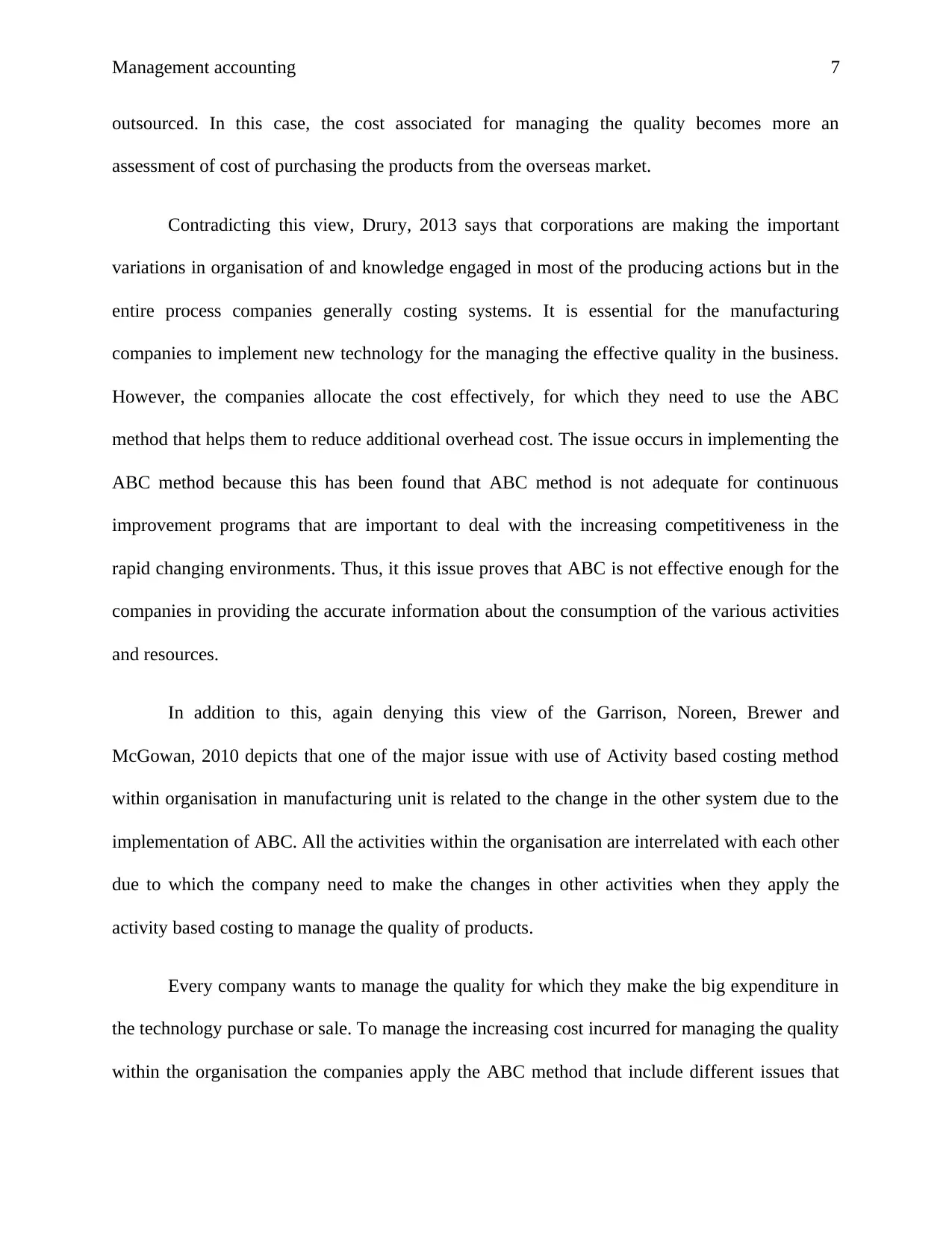
Management accounting 7
outsourced. In this case, the cost associated for managing the quality becomes more an
assessment of cost of purchasing the products from the overseas market.
Contradicting this view, Drury, 2013 says that corporations are making the important
variations in organisation of and knowledge engaged in most of the producing actions but in the
entire process companies generally costing systems. It is essential for the manufacturing
companies to implement new technology for the managing the effective quality in the business.
However, the companies allocate the cost effectively, for which they need to use the ABC
method that helps them to reduce additional overhead cost. The issue occurs in implementing the
ABC method because this has been found that ABC method is not adequate for continuous
improvement programs that are important to deal with the increasing competitiveness in the
rapid changing environments. Thus, it this issue proves that ABC is not effective enough for the
companies in providing the accurate information about the consumption of the various activities
and resources.
In addition to this, again denying this view of the Garrison, Noreen, Brewer and
McGowan, 2010 depicts that one of the major issue with use of Activity based costing method
within organisation in manufacturing unit is related to the change in the other system due to the
implementation of ABC. All the activities within the organisation are interrelated with each other
due to which the company need to make the changes in other activities when they apply the
activity based costing to manage the quality of products.
Every company wants to manage the quality for which they make the big expenditure in
the technology purchase or sale. To manage the increasing cost incurred for managing the quality
within the organisation the companies apply the ABC method that include different issues that
outsourced. In this case, the cost associated for managing the quality becomes more an
assessment of cost of purchasing the products from the overseas market.
Contradicting this view, Drury, 2013 says that corporations are making the important
variations in organisation of and knowledge engaged in most of the producing actions but in the
entire process companies generally costing systems. It is essential for the manufacturing
companies to implement new technology for the managing the effective quality in the business.
However, the companies allocate the cost effectively, for which they need to use the ABC
method that helps them to reduce additional overhead cost. The issue occurs in implementing the
ABC method because this has been found that ABC method is not adequate for continuous
improvement programs that are important to deal with the increasing competitiveness in the
rapid changing environments. Thus, it this issue proves that ABC is not effective enough for the
companies in providing the accurate information about the consumption of the various activities
and resources.
In addition to this, again denying this view of the Garrison, Noreen, Brewer and
McGowan, 2010 depicts that one of the major issue with use of Activity based costing method
within organisation in manufacturing unit is related to the change in the other system due to the
implementation of ABC. All the activities within the organisation are interrelated with each other
due to which the company need to make the changes in other activities when they apply the
activity based costing to manage the quality of products.
Every company wants to manage the quality for which they make the big expenditure in
the technology purchase or sale. To manage the increasing cost incurred for managing the quality
within the organisation the companies apply the ABC method that include different issues that
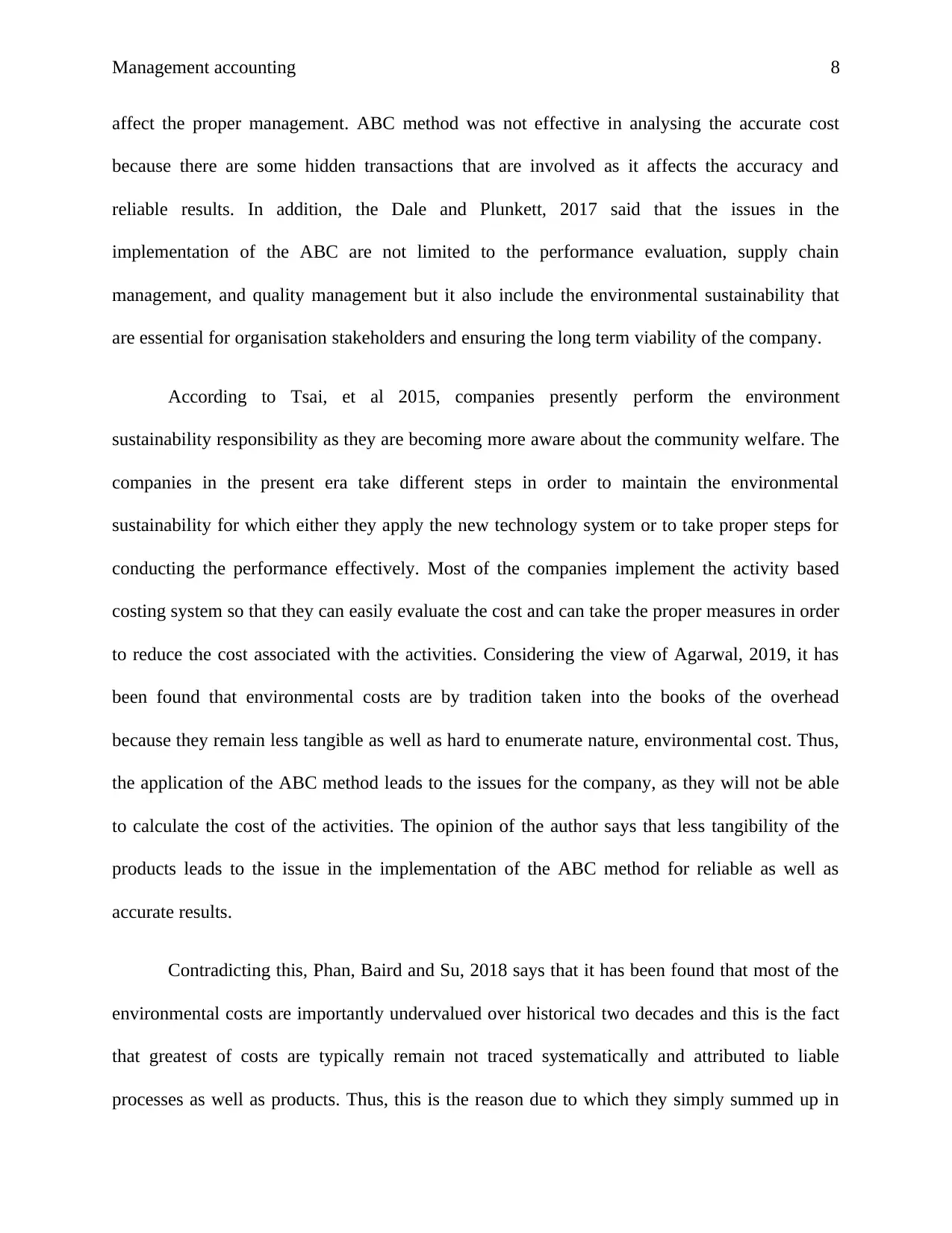
Management accounting 8
affect the proper management. ABC method was not effective in analysing the accurate cost
because there are some hidden transactions that are involved as it affects the accuracy and
reliable results. In addition, the Dale and Plunkett, 2017 said that the issues in the
implementation of the ABC are not limited to the performance evaluation, supply chain
management, and quality management but it also include the environmental sustainability that
are essential for organisation stakeholders and ensuring the long term viability of the company.
According to Tsai, et al 2015, companies presently perform the environment
sustainability responsibility as they are becoming more aware about the community welfare. The
companies in the present era take different steps in order to maintain the environmental
sustainability for which either they apply the new technology system or to take proper steps for
conducting the performance effectively. Most of the companies implement the activity based
costing system so that they can easily evaluate the cost and can take the proper measures in order
to reduce the cost associated with the activities. Considering the view of Agarwal, 2019, it has
been found that environmental costs are by tradition taken into the books of the overhead
because they remain less tangible as well as hard to enumerate nature, environmental cost. Thus,
the application of the ABC method leads to the issues for the company, as they will not be able
to calculate the cost of the activities. The opinion of the author says that less tangibility of the
products leads to the issue in the implementation of the ABC method for reliable as well as
accurate results.
Contradicting this, Phan, Baird and Su, 2018 says that it has been found that most of the
environmental costs are importantly undervalued over historical two decades and this is the fact
that greatest of costs are typically remain not traced systematically and attributed to liable
processes as well as products. Thus, this is the reason due to which they simply summed up in
affect the proper management. ABC method was not effective in analysing the accurate cost
because there are some hidden transactions that are involved as it affects the accuracy and
reliable results. In addition, the Dale and Plunkett, 2017 said that the issues in the
implementation of the ABC are not limited to the performance evaluation, supply chain
management, and quality management but it also include the environmental sustainability that
are essential for organisation stakeholders and ensuring the long term viability of the company.
According to Tsai, et al 2015, companies presently perform the environment
sustainability responsibility as they are becoming more aware about the community welfare. The
companies in the present era take different steps in order to maintain the environmental
sustainability for which either they apply the new technology system or to take proper steps for
conducting the performance effectively. Most of the companies implement the activity based
costing system so that they can easily evaluate the cost and can take the proper measures in order
to reduce the cost associated with the activities. Considering the view of Agarwal, 2019, it has
been found that environmental costs are by tradition taken into the books of the overhead
because they remain less tangible as well as hard to enumerate nature, environmental cost. Thus,
the application of the ABC method leads to the issues for the company, as they will not be able
to calculate the cost of the activities. The opinion of the author says that less tangibility of the
products leads to the issue in the implementation of the ABC method for reliable as well as
accurate results.
Contradicting this, Phan, Baird and Su, 2018 says that it has been found that most of the
environmental costs are importantly undervalued over historical two decades and this is the fact
that greatest of costs are typically remain not traced systematically and attributed to liable
processes as well as products. Thus, this is the reason due to which they simply summed up in
⊘ This is a preview!⊘
Do you want full access?
Subscribe today to unlock all pages.

Trusted by 1+ million students worldwide
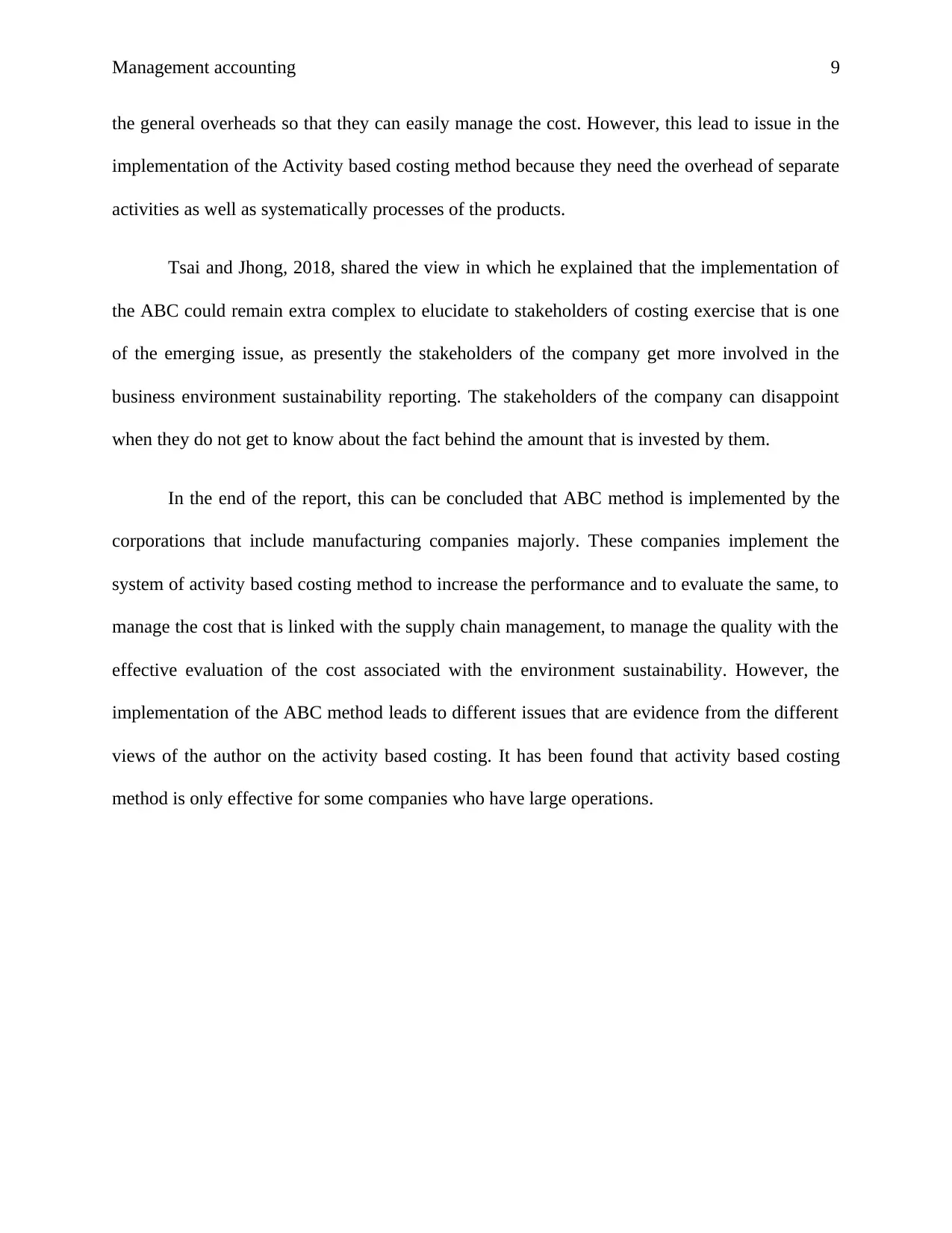
Management accounting 9
the general overheads so that they can easily manage the cost. However, this lead to issue in the
implementation of the Activity based costing method because they need the overhead of separate
activities as well as systematically processes of the products.
Tsai and Jhong, 2018, shared the view in which he explained that the implementation of
the ABC could remain extra complex to elucidate to stakeholders of costing exercise that is one
of the emerging issue, as presently the stakeholders of the company get more involved in the
business environment sustainability reporting. The stakeholders of the company can disappoint
when they do not get to know about the fact behind the amount that is invested by them.
In the end of the report, this can be concluded that ABC method is implemented by the
corporations that include manufacturing companies majorly. These companies implement the
system of activity based costing method to increase the performance and to evaluate the same, to
manage the cost that is linked with the supply chain management, to manage the quality with the
effective evaluation of the cost associated with the environment sustainability. However, the
implementation of the ABC method leads to different issues that are evidence from the different
views of the author on the activity based costing. It has been found that activity based costing
method is only effective for some companies who have large operations.
the general overheads so that they can easily manage the cost. However, this lead to issue in the
implementation of the Activity based costing method because they need the overhead of separate
activities as well as systematically processes of the products.
Tsai and Jhong, 2018, shared the view in which he explained that the implementation of
the ABC could remain extra complex to elucidate to stakeholders of costing exercise that is one
of the emerging issue, as presently the stakeholders of the company get more involved in the
business environment sustainability reporting. The stakeholders of the company can disappoint
when they do not get to know about the fact behind the amount that is invested by them.
In the end of the report, this can be concluded that ABC method is implemented by the
corporations that include manufacturing companies majorly. These companies implement the
system of activity based costing method to increase the performance and to evaluate the same, to
manage the cost that is linked with the supply chain management, to manage the quality with the
effective evaluation of the cost associated with the environment sustainability. However, the
implementation of the ABC method leads to different issues that are evidence from the different
views of the author on the activity based costing. It has been found that activity based costing
method is only effective for some companies who have large operations.
Paraphrase This Document
Need a fresh take? Get an instant paraphrase of this document with our AI Paraphraser
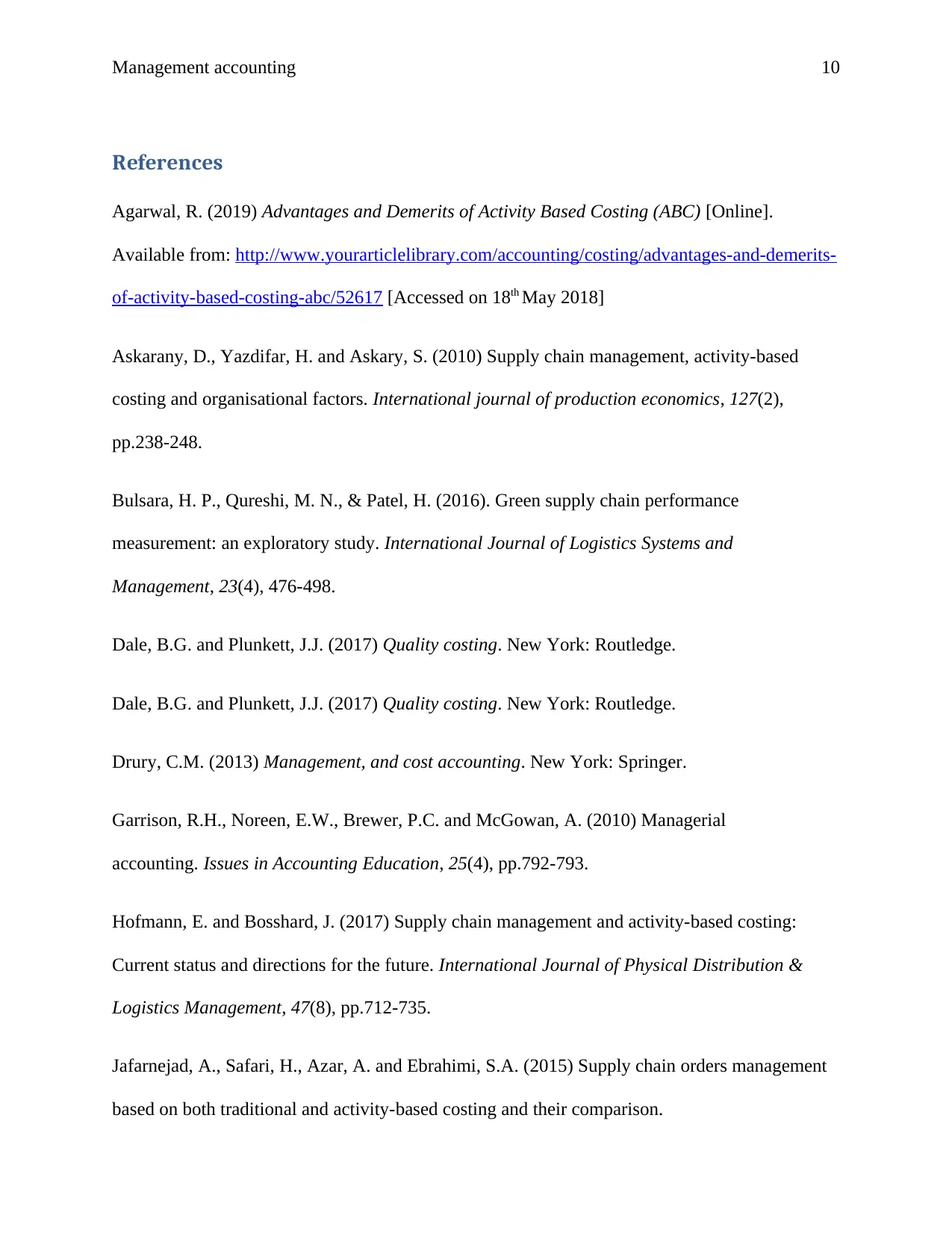
Management accounting 10
References
Agarwal, R. (2019) Advantages and Demerits of Activity Based Costing (ABC) [Online].
Available from: http://www.yourarticlelibrary.com/accounting/costing/advantages-and-demerits-
of-activity-based-costing-abc/52617 [Accessed on 18th May 2018]
Askarany, D., Yazdifar, H. and Askary, S. (2010) Supply chain management, activity-based
costing and organisational factors. International journal of production economics, 127(2),
pp.238-248.
Bulsara, H. P., Qureshi, M. N., & Patel, H. (2016). Green supply chain performance
measurement: an exploratory study. International Journal of Logistics Systems and
Management, 23(4), 476-498.
Dale, B.G. and Plunkett, J.J. (2017) Quality costing. New York: Routledge.
Dale, B.G. and Plunkett, J.J. (2017) Quality costing. New York: Routledge.
Drury, C.M. (2013) Management, and cost accounting. New York: Springer.
Garrison, R.H., Noreen, E.W., Brewer, P.C. and McGowan, A. (2010) Managerial
accounting. Issues in Accounting Education, 25(4), pp.792-793.
Hofmann, E. and Bosshard, J. (2017) Supply chain management and activity-based costing:
Current status and directions for the future. International Journal of Physical Distribution &
Logistics Management, 47(8), pp.712-735.
Jafarnejad, A., Safari, H., Azar, A. and Ebrahimi, S.A. (2015) Supply chain orders management
based on both traditional and activity-based costing and their comparison.
References
Agarwal, R. (2019) Advantages and Demerits of Activity Based Costing (ABC) [Online].
Available from: http://www.yourarticlelibrary.com/accounting/costing/advantages-and-demerits-
of-activity-based-costing-abc/52617 [Accessed on 18th May 2018]
Askarany, D., Yazdifar, H. and Askary, S. (2010) Supply chain management, activity-based
costing and organisational factors. International journal of production economics, 127(2),
pp.238-248.
Bulsara, H. P., Qureshi, M. N., & Patel, H. (2016). Green supply chain performance
measurement: an exploratory study. International Journal of Logistics Systems and
Management, 23(4), 476-498.
Dale, B.G. and Plunkett, J.J. (2017) Quality costing. New York: Routledge.
Dale, B.G. and Plunkett, J.J. (2017) Quality costing. New York: Routledge.
Drury, C.M. (2013) Management, and cost accounting. New York: Springer.
Garrison, R.H., Noreen, E.W., Brewer, P.C. and McGowan, A. (2010) Managerial
accounting. Issues in Accounting Education, 25(4), pp.792-793.
Hofmann, E. and Bosshard, J. (2017) Supply chain management and activity-based costing:
Current status and directions for the future. International Journal of Physical Distribution &
Logistics Management, 47(8), pp.712-735.
Jafarnejad, A., Safari, H., Azar, A. and Ebrahimi, S.A. (2015) Supply chain orders management
based on both traditional and activity-based costing and their comparison.
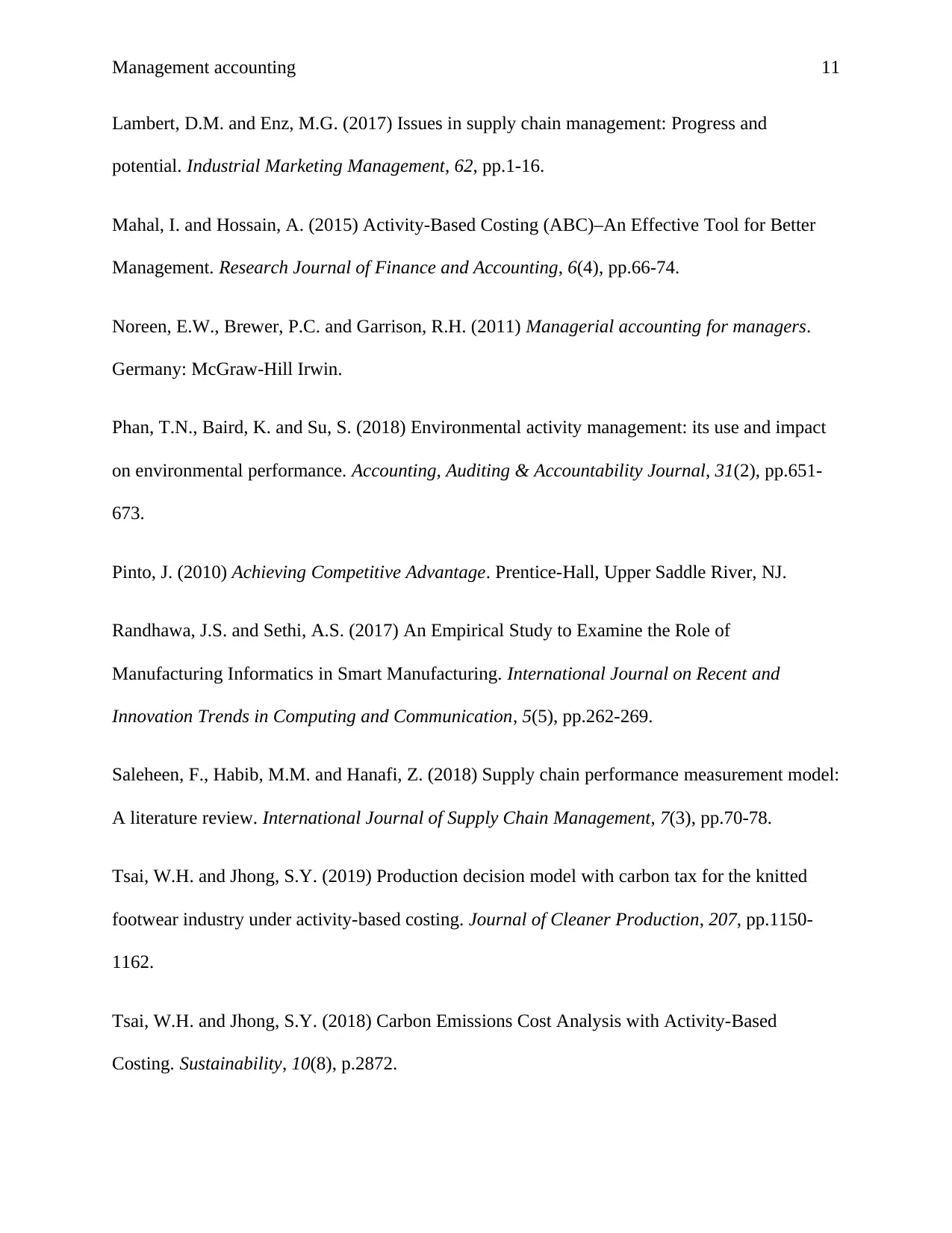
Management accounting 11
Lambert, D.M. and Enz, M.G. (2017) Issues in supply chain management: Progress and
potential. Industrial Marketing Management, 62, pp.1-16.
Mahal, I. and Hossain, A. (2015) Activity-Based Costing (ABC)–An Effective Tool for Better
Management. Research Journal of Finance and Accounting, 6(4), pp.66-74.
Noreen, E.W., Brewer, P.C. and Garrison, R.H. (2011) Managerial accounting for managers.
Germany: McGraw-Hill Irwin.
Phan, T.N., Baird, K. and Su, S. (2018) Environmental activity management: its use and impact
on environmental performance. Accounting, Auditing & Accountability Journal, 31(2), pp.651-
673.
Pinto, J. (2010) Achieving Competitive Advantage. Prentice-Hall, Upper Saddle River, NJ.
Randhawa, J.S. and Sethi, A.S. (2017) An Empirical Study to Examine the Role of
Manufacturing Informatics in Smart Manufacturing. International Journal on Recent and
Innovation Trends in Computing and Communication, 5(5), pp.262-269.
Saleheen, F., Habib, M.M. and Hanafi, Z. (2018) Supply chain performance measurement model:
A literature review. International Journal of Supply Chain Management, 7(3), pp.70-78.
Tsai, W.H. and Jhong, S.Y. (2019) Production decision model with carbon tax for the knitted
footwear industry under activity-based costing. Journal of Cleaner Production, 207, pp.1150-
1162.
Tsai, W.H. and Jhong, S.Y. (2018) Carbon Emissions Cost Analysis with Activity-Based
Costing. Sustainability, 10(8), p.2872.
Lambert, D.M. and Enz, M.G. (2017) Issues in supply chain management: Progress and
potential. Industrial Marketing Management, 62, pp.1-16.
Mahal, I. and Hossain, A. (2015) Activity-Based Costing (ABC)–An Effective Tool for Better
Management. Research Journal of Finance and Accounting, 6(4), pp.66-74.
Noreen, E.W., Brewer, P.C. and Garrison, R.H. (2011) Managerial accounting for managers.
Germany: McGraw-Hill Irwin.
Phan, T.N., Baird, K. and Su, S. (2018) Environmental activity management: its use and impact
on environmental performance. Accounting, Auditing & Accountability Journal, 31(2), pp.651-
673.
Pinto, J. (2010) Achieving Competitive Advantage. Prentice-Hall, Upper Saddle River, NJ.
Randhawa, J.S. and Sethi, A.S. (2017) An Empirical Study to Examine the Role of
Manufacturing Informatics in Smart Manufacturing. International Journal on Recent and
Innovation Trends in Computing and Communication, 5(5), pp.262-269.
Saleheen, F., Habib, M.M. and Hanafi, Z. (2018) Supply chain performance measurement model:
A literature review. International Journal of Supply Chain Management, 7(3), pp.70-78.
Tsai, W.H. and Jhong, S.Y. (2019) Production decision model with carbon tax for the knitted
footwear industry under activity-based costing. Journal of Cleaner Production, 207, pp.1150-
1162.
Tsai, W.H. and Jhong, S.Y. (2018) Carbon Emissions Cost Analysis with Activity-Based
Costing. Sustainability, 10(8), p.2872.
⊘ This is a preview!⊘
Do you want full access?
Subscribe today to unlock all pages.

Trusted by 1+ million students worldwide
1 out of 14
Related Documents
Your All-in-One AI-Powered Toolkit for Academic Success.
+13062052269
info@desklib.com
Available 24*7 on WhatsApp / Email
![[object Object]](/_next/static/media/star-bottom.7253800d.svg)
Unlock your academic potential
Copyright © 2020–2025 A2Z Services. All Rights Reserved. Developed and managed by ZUCOL.





